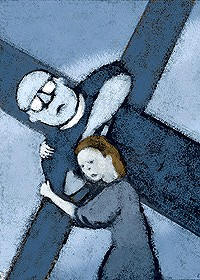| Laserium Tickets Free to
Temple of the Goddess
Remember the Laserium shows at
the Griffith Park Planetarium theater, Griffith Observatory?
Remember its amazing laser-beam shows set to the rhythm of
rock and roll music? Laserium is back in its new home at the
Laserium® CyberTheater™ on Hollywood and Vine.
Click here to print flyer/free admission ticket. Offer
good now through August 29th.
Losing my religion for equality
By Jimmy Carter
(Jimmy Carter was president of the United
States from 1977 to 1981)
July 15, 2009
Women and girls have been
discriminated against for too long in a twisted
interpretation of the word of God.
I HAVE been a practising [sic] Christian
all my life and a deacon and Bible teacher for many years.
My faith is a source of strength and comfort to me, as
religious beliefs are to hundreds of millions of people
around the world. So my decision to sever my ties with the
Southern Baptist Convention, after six decades, was painful
and difficult. It was, however, an unavoidable decision when
the convention's leaders, quoting a few carefully selected
Bible verses and claiming that Eve was created second to
Adam and was responsible for original sin, ordained that
women must be "subservient" to their husbands and prohibited
from serving as deacons, pastors or chaplains in the
military service.
This view that women are somehow inferior to men is not
restricted to one religion or belief. Women are prevented
from playing a full and equal role in many faiths. Nor,
tragically, does its influence stop at the walls of the
church, mosque, synagogue or temple. This discrimination,
unjustifiably attributed to a Higher Authority, has provided
a reason or excuse for the deprivation of women's equal
rights across the world for centuries.
At its most repugnant, the belief that women must be
subjugated to the wishes of men excuses slavery, violence,
forced prostitution, genital mutilation and national laws
that omit rape as a crime. But it also costs many millions
of girls and women control over their own bodies and lives,
and continues to deny them fair access to education, health,
employment and influence within their own communities.
The impact of these religious beliefs touches every aspect
of our lives. They help explain why in many countries boys
are educated before girls; why girls are told when and whom
they must marry; and why many face enormous and unacceptable
risks in pregnancy and childbirth because their basic health
needs are not met.
In some Islamic nations, women are restricted in their
movements, punished for permitting the exposure of an arm or
ankle, deprived of education, prohibited from driving a car
or competing with men for a job. If a woman is raped, she is
often most severely punished as the guilty party in the
crime.
The same discriminatory thinking lies behind the continuing
gender gap in pay and why there are still so few women in
office in the West. The root of this prejudice lies deep in
our histories, but its impact is felt every day. It is not
women and girls alone who suffer. It damages all of us. The
evidence shows that investing in women and girls delivers
major benefits for society. An educated woman has healthier
children. She is more likely to send them to school. She
earns more and invests what she earns in her family.
It is simply self-defeating for any community to
discriminate against half its population. We need to
challenge these self-serving and outdated attitudes and
practices - as we are seeing in Iran where women are at the
forefront of the battle for democracy and freedom.
I understand, however, why many political leaders can be
reluctant about stepping into this minefield. Religion, and
tradition, are powerful and sensitive areas to challenge.
But my fellow Elders and I, who come from many faiths and
backgrounds, no longer need to worry about winning votes or
avoiding controversy - and we are deeply committed to
challenging injustice wherever we see it.
The Elders are an independent group of eminent global
leaders, brought together by former South African president
Nelson Mandela, who offer their influence and experience to
support peace building, help address major causes of human
suffering and promote the shared interests of humanity. We
have decided to draw particular attention to the
responsibility of religious and traditional leaders in
ensuring equality and human rights and have recently
published a statement that declares: "The justification of
discrimination against women and girls on grounds of
religion or tradition, as if it were prescribed by a Higher
Authority, is unacceptable."
We are calling on all leaders to challenge and change the
harmful teachings and practices, no matter how ingrained,
which justify discrimination against women. We ask, in
particular, that leaders of all religions have the courage
to acknowledge and emphasise [sic] the positive messages of
dignity and equality that all the world's major faiths
share.
The carefully selected verses found in the Holy Scriptures
to justify the superiority of men owe more to time and place
- and the determination of male leaders to hold onto their
influence - than eternal truths. Similar biblical excerpts
could be found to support the approval of slavery and the
timid acquiescence to oppressive rulers.
I am also familiar with vivid descriptions in the same
Scriptures in which women are revered as pre-eminent
leaders. During the years of the early Christian church
women served as deacons, priests, bishops, apostles,
teachers and prophets. It wasn't until the fourth century
that dominant Christian leaders, all men, twisted and
distorted Holy Scriptures to perpetuate their ascendant
positions within the religious hierarchy.
The truth is that male religious leaders have had - and
still have - an option to interpret holy teachings either to
exalt or subjugate women. They have, for their own selfish
ends, overwhelmingly chosen the latter. Their continuing
choice provides the foundation or justification for much of
the pervasive persecution and abuse of women throughout the
world. This is in clear violation not just of the Universal
Declaration of Human Rights but also the teachings of Jesus
Christ, the Apostle Paul, Moses and the prophets, Muhammad,
and founders of other great religions - all of whom have
called for proper and equitable treatment of all the
children of God. It is time we had the courage to challenge
these views.
OBSERVER
Illustration: Dyson
Kid's Realm
Decoupage Tie-Dye Book Cover
By: Amanda Formaro
Difficulty: Easy
Age: 8 and up . . . Parental supervision is recommended
You’ll be the coolest kid in school with your very own
designer book cover! Choose tie-dye fabric like we did, or
pick out your own patterned cloth to suit your individual
tastes.
What you'll need:
● Large brown paper grocery bag or brown craft paper
● Fabric scraps
● White craft glue
● Small bowl
● Water
● Paintbrush
● Wax paper
● Scissors
● Textbook
How to make it:
1. First you will need to make the shell of the book cover.
Afterward, you will remove the book cover and decoupage it.
Begin by cutting the brown paper bag open: Using scissors,
cut from the top of the bag to the bottom at one of the
corner creases.
2. Cut the bottom off the bag completely. You should have a
long rectangle when finished.
3. Lay your text book in the center of the rectangle. Fold
the top and bottom of the rectangle up so that the height of
the rectangle is equal to the height of the text book.
Crease the folds by pressing with your fingers.
4. Bring the left side of the paper cover over the book and
line up the ends with the right side of the paper cover.
5. Open the book and fold the left side of the paper around
the cover of the book. Repeat this on the other side of the
book as well.
6. Open the cover of the book. You need to trim the paper to
about half the width of the actual book’s cover. Use a
pencil to mark the paper inside the cover where you will
trim it. Repeat this on the other side of the book as well.
Remove the cover from the book and trim off the excess paper
w ith
scissors. ith
scissors.
7. Carefully slide the front and back cover of the textbook
into the temporary paper cover to make sure it fits. Adjust
the height accordingly if the cover feels too snug or too
loose. (See photo at right) When you are happy, remove the
cover and set the textbook aside.
8. Line work surface with wax paper.
9. Mix together 2/3 glue and 1/3 water in a bowl with your
paintbrush. Use a soup or cereal sized bowl filled about
halfway. Make more if you run low.
10. Cut fabric into pieces, any size is fine. Approximately
2” x 2” is a nice workable size.
11. Open paper book cover and place the "good" side face up
onto the wax paper.
12. Begin by painting a 2” section in a top corner of the
paper with the glue mixture. Place a piece of fabric onto
the glue mixture. Add more glue mixture to your paintbrush
and paint over the top of the fabric scrap, smoothing with
your paintbrush as you go. Scrap should be saturated and
plat but not dripping. Repeat this process, covering the
paper completely, overlapping fabric pieces as you go.
13. When paper is covered with fabric, open the book cover
up and carefully place the textbook back inside it as you
did before you applied the fabric.
14. Carefully close the book; place a piece of wax paper in
between the front cover and the front page and the back
cover and the back page. This will keep the wet decoupage
cover from sticking to the actual textbook as it dries.
15. Allow to dry overnight then remove the wax paper from
the book.
Tips:
● Recycle old fabric by saving the
scraps in a zipper plastic bag or plastic container to use
for a future project.
● Personalize this project by cutting letters out of a
contrasting fabric color and decoupage child’s name on front
of cover.
● If any of the fabric scraps are sticking up after
drying, use white glue to stick them down.

How Coyote Became a Friend to Man
If you've heard
coyote's night calls, full of wildness and urgency, you
probably have an idea why the coyote has such a place in the
hearts and stories of the many cultures that have him or her
as a neighbor. The Karok Indians, who live along the Upper
Klamath River in the very northern part of California, tell
a wonderful story of how Coyote became a friend to man.
The Karok shaman tells
of how Chareya, the makers of all things, first created
fishes to use the water, then She make animals to use the
land, and birds to use the air. Last of all She made a man-a
Karok.
Chareya gave this
Karok the job of telling each animal its duties and position
in the world. The Karok man thought and worried about the
great power that he had been entrusted with, how would he
decide? Who was to have the most beautiful voice or who
would be the swiftest runner? These were hard choices and he
wanted to be fair. He called all the animals-the bears, the
mice, the mountain lions, the rabbits, and the bristly
porcupine.
He told them all to
return to him early in the morning and each of them would be
given a bow and arrow. He told them that the animal with the
longest bow would be the highest ranking animal of all, and
the one with the smallest bow would be the lowest in rank.
The animals looked at
each other nervously and the Karok repeated "Remember, be
here early."
Coyote wanted to be
the highest of all. His tail twitched with excitement. But
how could he be sure the Karok would choose him?
Coyote wrinkled his
brow in thought. The Karok had said to arrive early, what if
he arrived before anyone else? Perhaps, then, the Karok
would give the biggest bow to him. Coyote decided that was
the thing to do. In fact he decided not to sleep at all, and
then he would race to meet the Karok. So, instead of curling
up in his den to sleep as he usually did, Coyote paced
around and around to keep himself awake. But soon the fast
pacing made him so weary that he was yawning and yawning.
His eyelids grew so heavy, that he found himself running
around with his eyes shut. He tried plunging into the icy
cold stream that ran next to his den. He hated the feel of
the water against his skin and fur, but he felt sure it
would keep him awake.
And it seemed to work
for a while, but soon he was sleepy again. Desperately, he
sang songs to himself, songs about the giant bow and what he
would do with it. And then, just before dawn, Coyote fell
asleep. He woke up much later and his heart sank when he
realized what had happened. He raced from his den and ran
breathlessly into the meeting. He was the last animal there
and all that was left was the shortest bow.
Coyote was so
disappointed that he sat on his haunches howling for a whole
day and a whole night. This made the Karok Indian take pity
on him. He told Coyote he would talk to Chareya about how he
had tried to win the longest bow.
When the Karok
returned, he told Coyote that Chareya, after careful thought
about Coyote, had decreed that Coyote should become the most
crafty and cunning of all animals.
Coyote was so pleased
that he threw away the bow. He was so grateful to the Karok
that he made a promise to always be his friend and the
friend of Karok's children and his children's children.
And to this day Coyote
continues to be our friend. He is eager to share his
medicine and teachings with us. Just ask him.
For more
information:
To learn more about
Coyote medicine you might spend some time studying coyotes.
Investigate how the coyote lives and what he/she is like.
Take a look at the cartoons of the roadrunner and Wiley
Coyote, and remember the power of laughter to heal.
The books Animal
Speak and Animal Wise by Ted Andrews include a
comprehensive dictionary of animal, bird, and reptile
symbolism. Also the Medicine Cards by Jamie Sams and David
Carson are a beautiful way to discover the wisdom contained
in the ways of our fellow animals.
۞ ۞ ۞
Animal Tales Column brought to you by Kamala.
Animal Tales logo by Anne Gauldin, Gauldin Farrington
Designs. |

